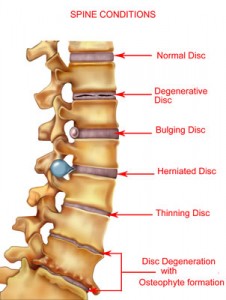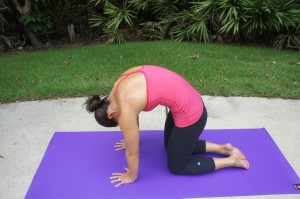 I know so many people who regularly experience low back pain that it seems like a “bad back” has become a part of everyday life. In some cases the pain came about due to an overuse or traumatic injury, but for others, it was “just there one day.” Back pain can really be a pain in the….well, back! So, I thought you might find it helpful to better understand some of the most common causes and natural treatments that can help you to avoid those pesky back problems.
I know so many people who regularly experience low back pain that it seems like a “bad back” has become a part of everyday life. In some cases the pain came about due to an overuse or traumatic injury, but for others, it was “just there one day.” Back pain can really be a pain in the….well, back! So, I thought you might find it helpful to better understand some of the most common causes and natural treatments that can help you to avoid those pesky back problems.
Behind Your Back
Your back is made up of bone and cartilage, discs, nerves, muscles, tendons, and ligaments. With all these hard and soft tissues in close quarters, keeping it balanced and healthy isn’t always easy. In order to have a healthy back, your discs must be properly aligned and spaced, the muscles and other soft tissue need to be strong yet flexible, and the nerves need to be free from impingement. While all of that just may not sound too complicated, there are actually so many ways we can put stress and strain on our back, it’s really no surprise that back pain affects so many people!
 Causes of Low Back Pain & Discomfort
Causes of Low Back Pain & Discomfort
Although none of us like to hear it, but as we get older we become more prone to back problems. The reason for this is that bone strength and muscle elasticity decrease, while the cartilage becomes weaker, thinner, and more frail. All of this increases the likelihood of problems such as muscle spasms, spinal compression, and even herniated or bulging discs.
To add to these physical conditions, our lifestyles create additional back problems. If you have any of the items on this list, you probably already know first-hand how annoying a “bad back” can be. Plus, the more hours we put into working, sitting, and/or overexerting; the worse it is for our spine. You can immediately feel when your body is tired, stiff, achy or painful because your spine is the first to show.
Below are some of the common actions and habits that can cause acute and chronic low back pain:
Sitting
Whether in front of a computer screen or on the couch for hours on end every day, sitting is very bad for your back because it puts more pressure on disks and vertebrae than standing or walking. To minimize the negative effects of sitting, take a health break every 1-2 hours and stretch your neck and shoulders and walk around for a few minutes.
Improper lifting techniques and poor posture
Being mentally and physically aware of your posture is SO important, and not just while exercising, but all throughout the day. As many jobs require a lot of physically demanding work, that means constant lifting, twisting, bending, pulling and pushing. Many times where people start to cause a slew of problems is when they bent, lift and twist using their back, while not fully engaging the legs and core. Activate your lower body and core with a strong spine, and learn how to improve your posture here.
Ignoring your core
While “6-pack” abs look nice, your back, sides, pelvic, buttocks and abdominal muscles make up your “core” which supports all of your movements. When you’re planning your workouts, make sure you incorporate exercises such as lunges and squats, and motions to include hip flexion, extension, hip abduction and adduction. Also include plank variations and carefully selected deep abdominal wall exercises to effectively strengthen your entire core from the front, to the back and even the sides.
Sleeping wrong
When sleeping, your spine should be in an elongated and neutral position, which can be attained through sleeping on your side with support of a pillow between the knees, or on your back, with a pillow under your knees. In addition, your head should be in line with your spine –so make sure your pillow isn’t too high or too low.
Frequent traveling (driving and flying)
Spending hours in the car or in any seated position period, will exacerbate pressure to your spinal column and compress your intervertebral discs. The variety of vibrations to your spine from a plane’s turbulence is hard to avoid when you’re flying, and so are the bumpy conditions of the road while driving in the car. Help this by using a small pillow to place in the small of your back while traveling to help absorb some of the pressure. Men: try removing your wallet from your back pocket before you sit down to avoid misalignment of your pelvis, which causes shortening of the muscles on one side of your low back, leading to a slew of problems.
Carrying extra pounds
Added weight around your midsection makes it difficult to keep your spinal column properly aligned. So, exercising provides the double benefit of stretching and strengthening your back, while helping minimize the weight you may be carrying around.
Wearing dress shoes
If you are a woman who frequently wears pumps and high heels, you probably feel a lot of relief when you take off your shoes at the end of the day. Heels force your foot forward, which changes the angle of your body, especially in the tilt of your pelvis, so your weight isn’t evenly distributed over the spine. And if you are a man who has the stylish kicks with a heavier sole, your low back takes a beating with each step.
Stress and repetitive activities that cause strain
When you’re stressed, whether you notice it or not, your back muscles tense up and after just a short period of time and they can start to spasm. Whether you have a lot on your plate for work and home, or you train hard on the bike or run, they still cause strain. Stress affects each of us in SO many different ways; this is one more reason to find a healthy stress-reducing activity that works for you; pool therapy, tai chi, gentle yoga and regular stretching, etc are great!
Treating Low Back Pain
There are many ways to treat general back pain without surgery, with exercise, ice, heat, and rest being at the top of the list. Additionally, some people experience relief through treatments such as chiropractic spinal manipulation, acupuncture, massage and manual therapy, traction, and transcutaneous electrical nerve stimulation (TENS). However, my favorite preventative and rehabilitative activities are proper functional exercise, aquatic therapy and effective stretching. A balanced exercise program can not only stretch and strengthen your back, it can truly help prevent the problems that create back pain in the first place.

Daily stretching alone can help minimize and even eliminate some forms of back pain. When you stretch the lower back muscles, hip flexors, quadriceps, and hamstrings, your back benefits. Double and Single Knee-to-Chest stretch, Child’s Pose (yoga), Angry Cat pose, and Runner’s Lunge stretches are just a few that are highly beneficial. Try these stretches to get started! Additionally, if you have access to a strong, stationary frame and a thick body-band, there are some sure-fire stretch movements that you can do yourself that can help you become more flexible.
As each person has a different source of back pain, it’s best if I work with you individually to design a program that will best meet your needs, while guiding you on how to execute each movement properly to avoid the potential of doing more harm than good. Be sure to check out my signature Range Of Motion Stretch Therapy services!
In Conclusion…
Back pain is definitely not something you can ignore and hope will go away on it’s own. I have had numerous clients try that (before coming to see me) and many of them ended up either stuck in bed for months and unable to move, sneeze, cough or laugh without excruciating pain, or desperate for pain killers, and some even thinking about surgery to “fix the problem”. Taking preventative and rehabilitative action to properly care for your back will serve you right in so many ways, for so many years. If you don’t know where to start, get with me to develop a personalized “Back-to-Health” program – together we will create a program of specific stretches and strengthening exercises to keep your back tip top shape and far away from pain.
